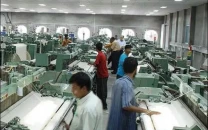Floods to drive up food prices as crops hit
Cotton, rice, wheat among worst-hit; imports expected to surge

Pakistan is bracing for a significant surge in food inflation in the coming months, as devastating floods have wreaked havoc on the country's agricultural sector, particularly in Punjab and Khyber-Pakhtunkhwa (K-P).
Initial estimates and a grim comparison with the 2022 flood crisis paint a worrying picture for consumers already grappling with economic challenges.
The rising water levels, which have submerged vast swathes of fertile land and displaced thousands, are expected to lead to severe shortages and price hikes for essential food items.
"Food prices are likely to pick up in the coming months due to losses and disruptions owing to the floods," noted Mustafa Mustansir, head of research at Taurus Securities, in a report.
This assessment is based on initial estimates and draws parallels with the price trends observed following the 2022 floods, suggesting that food inflation could accelerate from September onwards.
He highlighted that prices for certain fruits and vegetables have already seen a sharp increase, indicating the immediate impact of the crisis.
The National Disaster Management Authority (NDMA) has reported a staggering 819 deaths and over 8,658 damaged or destroyed houses. The livestock sector has also suffered immense losses, with 6,138 heads of livestock perished.
The K-P has been the hardest hit, enduring extensive infrastructure damage, including roads, bridges, powerhouses, and irrigation channels.
Meanwhile, Punjab continues to face widespread devastation as floodwaters, primarily released from the Indian side, relentlessly flow across its floodplains, forcing thousands to evacuate.
The active monsoon conditions are expected to persist until at least September 10, 2025, with further heavy rainfall anticipated in eastern Punjab, the K-P, Azad Kashmir, Gilgit-Baltistan, and Sindh, exacerbating flood risks in downstream districts.
The looming food crisis is not merely a projection but a stark reality for millions.
The report warned that items like wheat, rice, potatoes, onions, tomatoes, milk and eggs are the most vulnerable. Pressure may also be seen in the case of pulses and other food items, subject to the extent of the crop losses.
These staples form the bedrock of Pakistani households, and their increased prices will disproportionately affect low-income families, pushing many further into poverty.
Recalling the impact of the 2022 floods, the report noted that "month on month (MoM) growth in the prices of non-perishable food items averaged around 2.5% between July 2022 and December 2022. MoM growth in the prices of perishable food items averaged around 4.8% over the same period.
While food inflation had been on a decline from August 2024 to June 2025, averaging around 0.4% MoM, it registered a sharp increase of approximately 3% in July 2025. This sudden jump signals the beginning of what could be a sustained period of rising food costs.
The agricultural sector, the backbone of Pakistan's economy, has borne the brunt of the floods.
The report underscored that the growth target for the agriculture sector for FY26 is "most likely to be missed, impacting overall GDP growth too."
The cotton production, in particular, is severely affected, with domestic cotton arrivals already sharply down by 6% year-on-year for Punjab and 24% year-on-year for Sindh. This is likely to drive increased cotton imports in FY26, further straining the country's import bill.
Beyond immediate food shortages, the ripple effects of the floods are expected to cascade across various sectors. The fertiliser industry is anticipating a "sharp drop in demand" as agricultural activities grind to a halt in affected areas.
The automobile sector, especially passenger cars and 3-wheelers, will likely see a decline in sales from rural areas due to weakened farm economics.
Construction materials are also expected to experience a slowdown in dispatches due to disrupted construction activities, although post-flood reconstruction could eventually rebound demand.
The report also anticipated a potential drop in sales volumes for petroleum products as commute and economic activity are disrupted in affected areas.
The financial sector is not immune either. While a major drop in deposits is not anticipated, commercial banks could face "some loss of revenue due to branch-level disruptions."
More concerning is the expected "surge in Agribusiness NPLs" (Non-Performing Loans) as a consequence of flood-induced damages to clients, with the infection ratio of the Agriculture Sector already at approximately 5% as of March 2025.
Perhaps the most critical long-term concern is the impact on Pakistan's balance of payments. The floods are likely to "result in increasing Pakistan's import bill, in particular driving higher food imports due to domestic shortages."
Conversely, export proceeds may suffer due to the loss in production of key agricultural exports like rice and other fruits. This dual impact of increased imports and reduced exports will further strain the country's already precarious external account.
The report's base case for the National Consumer Price Index (NCPI) for FY26 now stands at 7.8% year-on-year, incorporating the impact of softer fuel prices going forward.
However, any "significant crop damage owing to the floods especially in parts of Sindh and Punjab is a key upside risk to our projections."
An upward revision in NCPI expectations also implies that "we do not anticipate any reduction in interest rates for the remainder of the current fiscal year," potentially hindering economic recovery.













1726134115-0/BeFunk_-(41)1726134115-0-208x130.webp)






COMMENTS
Comments are moderated and generally will be posted if they are on-topic and not abusive.
For more information, please see our Comments FAQ